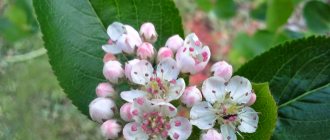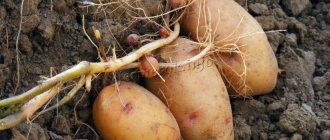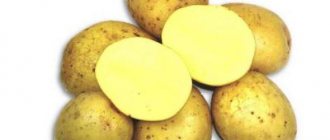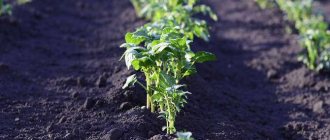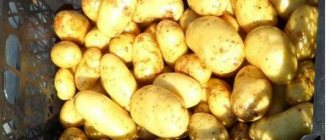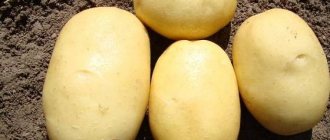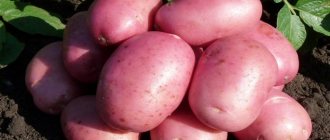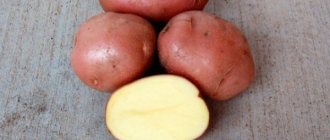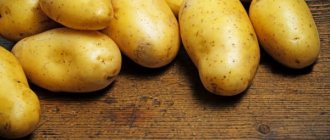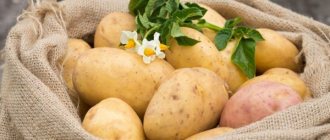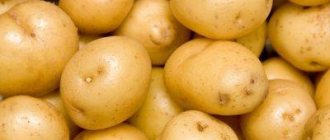Loading…
Loading…
High yield, large-fruited and resistant to most nightshade diseases. For these and other features, the Irbitsky potato variety, bred in 2009, has won the universal love of gardeners. It is also unpretentious to grow. Able to adapt to different weather conditions. It has excellent taste - it has a moderate potato taste. It has a very pleasant rich aroma due to its low sugar content. Root vegetables do not become soft during cooking. Given all this, every farmer will want to know a little more about this variety.
The history of the origin of the Irbitsky potato variety
The Irbitsky potato was developed by Russian breeders in 2009.
The variety is included in the State Register of Russia.
Recommended for cultivation in the Volga-Vyatka and West Siberian regions.
The table below presents data on the yield of other potato varieties:
| Name | Variety | Productivity |
| Nikulinsky | Late ripening | From 170 to 300 centners per hectare. |
| Cardinal | Late ripening | From 200 to 350 centners of potatoes are harvested from 1 hectare. |
| Rocco | Late ripening | From 350 to 400 centners per hectare. |
| Kiwi | Late ripening | From 1 kg of planting tubers it reaches 20 kg. |
| Picasso | Late ripening | From 1 hectare about 20 tons. |
| Borovichok | Early ripening | 200-250 centners per 1 hectare of land. |
| Elmundo | Early ripening | 250-350 centners per hectare. |
| Felox | Early ripening | 250 centners per hectare. |
| Bellarosa | Early ripening | The harvest from one bush is 8-10 tubers. |
| Natasha | Early ripening | From 130 to 190 centners per hectare. |
| Forty days | Extra early | Up to 300 centners of potatoes are harvested from one hectare of soil. |
| Karatop | Extra early | From 18.5 to 27 tons per hectare (Middle Volga region), from 20 to 43.5 tons per hectare (Northwestern region). The maximum yield is 50 tons per hectare. |
| Riviera | Extra early | After the first digging on the 45th day after the emergence of potato shoots, it ranges from 134 to 225 centners per hectare. The maximum yield by the end of the growing season reaches 450 centners per hectare. |
| Zhukovsky early | Extra early | The harvest from one bush is up to 15 tubers. |
| Minerva | Extra early | Fertile soils allow you to harvest the first harvest of up to 230 centners per hectare. By the end of the growing season (45-50 days), the maximum yield is achieved - up to 430 centners per hectare. |
| Crane | Mid-late | 640 centners per hectare. |
| Sorcerer | Mid-late | Productivity varies from 27 to 35 tons per hectare. |
| Mozart | Mid-late | The average yield is approximately 430 c/ha. |
| Grenada | Mid-late | From one hectare you can harvest up to 60 tons of potatoes. |
| Ramona | Mid-late | The yield is consistently average from 10 to 15 tons per hectare. |
| Yanka | Mid-early | The average yield ranges from 195 to 315 centners per hectare. |
| Giant | Mid-early | The average harvest ranges from 290 to 424 centners per hectare. |
| Tuscany | Mid-early | Productivity varies from 210 to 400 centners per hectare. |
| Purple Haze | Mid-early | Productivity varies from 182 to 309 centners per hectare. |
| Santana | Mid-early | The average yield varies from 164 to 384 centners per hectare. |
Potato care
Although this variety is considered unpretentious, you will still need to follow some care rules. Let's get acquainted with them further.
Watering
Irbit potatoes easily tolerate drought, but to get a good harvest, it is still necessary to irrigate if the summer is dry and rains are rare. This cannot be avoided during the period of seed ascension, as well as when the potatoes begin to bud and bloom. It is advisable that the soil is moist at the time of tuber formation. This time falls in August.
Hilling
Hilling is considered a prerequisite for growing potatoes. It is held 2 times a season. This is necessary to increase air access to the tubers. The first time the potatoes are earthed up is when the stems grow to 15 cm. They try to fill a ridge of soil about 20 cm. The next time is when the stems become about 30 cm. It is recommended to do the earthing after rain.
Fertilizing
Like all plants, Irbitsky potatoes need to be fed. The first time - after the first hilling
You can pour complex mineral fertilizers, but it is important to follow the proportion specified in the instructions
You will also need to water the potatoes with slurry, which is recommended to be prepared from chicken droppings. But you need to remember that you need to correctly calculate the concentration, otherwise you can burn the plants. Usually take 1 part of chicken manure and add 15 parts of water. They insist for several days. Then water at the rate of 1 liter per plant. When fertilizing, you need to pour this infusion right to the roots so as not to damage the stems and leaves.
It is useful to feed potatoes through the leaves. To do this, take nettle and infuse it for several days, and then spray the leaves with this infusion. It is also recommended to water the potatoes with a solution obtained by mixing 30 g of nitrogen, potassium and phosphorus fertilizers in 1 bucket of water.
Disease and pest control
Irbit potatoes must be treated against the following pests:
- Colorado potato beetle. It is considered a major and dangerous pest. If measures are not taken, the larvae can completely destroy all the leaves, leaving only bare stems. To prevent it from spreading, it is recommended to treat potatoes with herbal remedies. This can be an infusion of wormwood, celandine or walnut leaves. Chemical preparations are also suitable - Aktara, Bankol, Colorado, Regent, etc. If the area is small, it is recommended to collect the larvae by hand.
- Wireworm. This worm is considered to be the larva of the click beetle. It penetrates inside the tuber, damaging it. After this, the potatoes may rot. The fight against it consists of adding lime to the soil if it is acidic. In addition, digging and loosening of the soil is required.
- Stem nematode. These are very small white worms, about 0.4 cm in size. They are almost invisible when they settle on potato tubers. Nematodes damage its integrity. Only when the potatoes are dug up do they notice that the skin peels off and its top layer turns black. To prevent the appearance of these worms, it is recommended to monitor the quality of the seeds and dig up the soil in the fall.
- Medvedki. This insect causes great harm to many plants, including potatoes. It lives in the earth. Constantly digs holes, cutting off roots and stems, and then damages the tubers. It is necessary to fight the mole cricket by preparing special baits, which should include boiled grain and poison in the form of Karbofos.
- Cutworm caterpillars. They can be everywhere on potatoes because they feed on leaves, stems and tubers. After them, the stems become damaged, and various types of rot form on the wounds. To combat them, biological products are used.
As for diseases, late blight poses a danger. It develops more often in cool and rainy weather, more closely resembling potato rot, which spreads first on the stems and leaves. They turn yellow and become covered with grayish spots. After rain, fungal spores fall on the ground and penetrate the tubers. When harvesting, it is not noticeable that the tubers are affected by late blight, but they are not stored for a long time, so they rot after a while.
For prevention, it is recommended to treat the tops with copper sulfate. You need to dissolve 5 g of vitriol in 5 liters of water, and then sprinkle the resulting mixture on the potato tops when the stems grow to a height of 20 cm.
Description and characteristics of the variety
Irbitsky is an unpretentious mid-season potato variety intended for cultivation in temperate and northern climate zones. From the beginning of germination to the digging of tubers, it often takes from 70 to 90 days, this makes it possible to obtain a harvest even in areas with short summers. The plant was bred not so long ago: in 2009, the variety was first submitted for industrial testing, after which it instantly conquered the modern market of fruit species. The authors of the plant were Russian breeders from the Ural Research Institute of the Russian Agricultural Academy.
This potato has typical morphological features: it is a medium-sized herbaceous plant, with a semi-erect stem and an intermediate growth pattern. The height of the plant is within 50–60 cm. The leaves are large or medium in size, of intermediate type, the color of the leaves is rich, bright green. The leaf blade is unpaired and consists of 3–7 lobes. The variety blooms amicably and abundantly. At this time, small flowers with anthocyon color on the inside develop on the bush. After flowering, fruits appear on the bush - multi-seeded berries of a light green hue, about 2 cm in diameter.
In their shape and structure they are similar to tomato fruits. The berries are poisonous, so they are not used as food. The tubers of the variety are round, slightly oblong, with red-yellow skin. Small dark red eyes develop on the tubers. When cut, the pulp of the tubers is dense, watery, and has a rich pale yellow hue. The size of the tubers is average, the weight of the average specimen does not exceed 190 g.
The crop yield is high: under optimal growing conditions, you can harvest from 25 to 40 tons per hectare. The taste of potatoes is increased; the tubers are characterized by a fairly high starch content and low sugar content. This makes the pulp moderately rich in aromatic substances and pleasant to the taste. In turn, dishes made from this potato have a moderate potato taste, which makes it universal for preparing any dishes and side dishes.
Preparing for landing
Before planting, you need to prepare the potatoes.
- Planting material is selected. Tubers must be healthy, without damage.
- Calibration is carried out according to the size of root crops.
- Large tubers are cut into several parts. Each should have two or three eyes.
- The tubers are germinating.
- Treatment of potatoes with protective agents and fertilizers.
Before planting, a high yield is obtained by pre-soaking the tubers in fertilizer solutions. To prepare them, take four hundred grams of saltpeter and superphosphate and dissolve them in 10 liters of water. The tubers are immersed in this solution for an hour. During this time, potatoes absorb useful elements and activate the growth and development of root crops and aerial parts. With this soaking, you can get the harvest a week ahead of schedule.
How to grow this variety
The Irbitsky variety is cultivated both on large areas for industrial use and on small garden plots.
Since the variety does not require care and can be grown even in unfavorable climatic conditions, it can be easily grown in your garden.
Dates, scheme and rules of planting
Three weeks before planting, potatoes are taken out of storage and sorted, removing diseased or rotten tubers. To germinate, they are left in a warm and bright place. Large tubers are cut so that each cut part has 2-3 eyes. They are treated with growth stimulants and drugs to protect against pests and diseases.
Important ! For Irbit potatoes, acidic soil is more suitable than alkaline soil.
Potatoes are planted in an open, sunny place without drafts. The planting scheme is as follows: 60 cm are left between plants, 35 cm between rows. The tubers are placed in pre-dug furrows to a depth of 8-10 cm. Ash containing phosphorus and potassium, as well as ammophos or mullein, sources of nitrogen, are added to the holes. These substances are necessary for the development of the tuber and plant growth.
Planting tubers in unheated soil leads to their rotting and late germination (after about a month and a half), and being late in planting just a couple of weeks reduces the harvest by 20%. Therefore, determine planting dates with maximum accuracy.
Early planting is preferable, but the soil should already warm up to +7...+8°C. This time falls approximately in mid-May, not earlier. The best predecessors for this variety are legumes, cucumbers and pumpkin.
Care
Since in most regions hot and dry summer days alternate with cool and humid ones, it is not easy to develop a universal care scheme for the Irbitsky potato variety. However, there are agricultural practices that are standard for any weather. This includes loosening and removing weeds, hilling (it is necessary for the growth of lateral underground shoots on which tubers develop), watering and fertilizing with organic and mineral fertilizers.
The first loosening (before emergence) is deep - 10-12 cm. The second and third - no deeper than 6-7 cm.
The first hilling is when the plant height is 15-17 cm, the height of the soil ridge will be 18-20 cm. The second hilling is before the tops are closed.
It is recommended to combine watering and fertilizing with each other. It is enough to carry out these agrotechnical activities no more than three times per season:
- 2 parts chicken manure and 30 parts water. Before fertilizing, the soil should be moist so as not to burn the roots;
- 2 parts of chicken manure or mullein are diluted with 30 parts of water. This feeding is carried out during the formation of buds;
- 4 tablespoons of ash are mixed with 1.5 tablespoons of potassium sulfate per 1 linear meter. Treatment is carried out during flowering of plants.
One potato bush requires 1 liter of fertilizer solution
Nuances of cultivation and possible difficulties, diseases and pests
The Irbitsky variety deserves all 5 points on a 5-point scale for resistance to pests and diseases. However, some difficulties during cultivation cannot be ruled out:
- Colorado beetle. For prevention, tubers are treated before planting and/or bushes before flowering with the preparations “Alatar”, “Aktara”, “Prestige”, etc.
- Wireworm. Before planting, “bait” (pieces of potato, cake) with poisons are scattered over the area.
- Late blight. Brown spots appear on the leaves on top, and a white coating appears on the bottom. The disease affects all parts of the plant and occurs towards the end of summer, when the air temperature drops sharply and it rains. The virus quickly spreads from leaves to stems and tubers. The tubers become covered with hard brownish areas and then rot. To prevent the entire crop from being lost from this disease, diseased bushes are sprayed with a solution of Bordeaux mixture.
- Ring rot . The fungus attacks the vascular tissues of the stem and tubers. It looks like cream-colored circles with transparent glassy inclusions nearby. Careful selection of planting material and its treatment with fungicides is the best prevention of this disease.
- Scab. Irregular ulcers with a dry rim appear on the tubers. The fruits are stored for a long time, but dry out over time. Control measures include maintaining crop rotation, planting high-quality material and using fungicides in case of infection.
Cucumber Herman f1 – photo and description, planting and care, reviews
Features of cultivation
Growing Irbitsky potatoes is not difficult, unlike most varieties, since they are unpretentious and do not have unique original growing methods. Nevertheless, it is still worth following some recommendations.
How to choose the right place
Irbitsky seed potatoes: video about the variety
Irbitsky potatoes have proven themselves well when grown in not the most favorable conditions, but it’s not worth the risk. Like almost all root vegetables, this type of variety loves a sunny place, without drafts. Soil requirements The Irbitsky potato does not require a special soil composition, but loose soil with excellent air exchange is ideal for growing it. The land must be freed from weeds, as they take away useful nutrients from the soil. The best predecessors are legumes. If desired, you can add mineral and organic fertilizers to the soil.
Features of the variety
Description:
- Mid-season variety. Young potatoes can be dug up after 2 months. Full maturation occurs after 3 months;
- The tops are of medium size, do not grow much, the main branches grow straight upward. The leaves grow densely, are medium in size, bright green in color and have a carved edge. The flowers are blue in color;
- The fruits are smooth, oval with a dense pink skin and sparse small eyes. The pulp is a delicate yellow shade. The taste and aroma are pronounced and intense.
Characteristics of Irbitsky potatoes
| Parameter | Meaning |
| Productivity | Up to 400 c/ha |
| Weight of 1 fruit | On average 150 g. |
| Number of fruits on a branch | 6-10 pieces |
| Ripening period | 2.5-3 months |
| Bush height | 0.65 m |
| Safety in winter | 0.96 |
| Starchiness | 0.17 |
Description of the variety
Roots:
- Round tubers;
- Red peel;
- Small eyes;
- The pulp is light yellow when cut;
- Starch content from 13 to 16.5%;
- Average weight from 110 to 190 grams;
- The harvest from one bush reaches 6-8 tubers.
Super elite potatoes “Red Scarlet”, “Irbitsky”, “Zekura”:
Bushes:
- The plant is semi-erect, intermediate type, reaches medium height;
- Dark green leaves, medium size, intermediate type;
- The flower corollas are medium-sized with intense anthocyanin coloration on the inside.
Advantages and disadvantages of Irbitsky
Irbitsky has long won the title of one of the best varieties for cultivation. Many gardeners give it the status of “Elite”.
And this title is not just big words. Irbitsky has a number of advantages, thanks to which gardeners praise it. In particular, the positive aspects of this variety include:
- Everyone who grew Irbitsky notes its exceptional adaptation to any growing conditions.
- Also, the variety is famous for its high and stable yield.
- Another advantage is the high commercial quality of the tubers.
- The variety is excellent for commercial production, since the safety of the tubers is within 97%.
- Irbitsky has fairly good immunity, which protects it from most potato fungal diseases.
- The variety is not prone to degeneration.
- Unlike some varieties, Irbitsky can be cut when planting. This does not affect the yield in any way.
- Irbitsky is easy to care for.
- Tubers are resistant to mechanical damage.
- Small root vegetables are very rare.
There are no disadvantages as such. Disease damage and poor yields may occur, and then only with a complete lack of care.
Characteristic
The description of the Irbitsky potato variety must begin with the period of technical maturation of the tubers. From planting to the first harvest it takes 65-70 days, and in cooler climates - 90 days. For this reason, it is classified as mid-season. The crop is intended for cultivation in the West Siberian and Volga-Vyatka regions. In addition, it is widespread in Moldova and Ukraine.
The characteristics of the Irbitsky potato variety also include a detailed description of the root crop, which has:
- round slightly oblong shape;
- small ruby-colored eyes;
- reddish skin;
- light yellow pulp;
- weight up to 100-190 g;
- high starch content: 12-17% (the percentage depends on the nutritional value of the soil);
- low sugar levels.
The bush of the plant has semi-erect stems of medium height (50-60 cm). The unpaired foliage of the crop is larger than average in size. The edges are wavy. It has a dark green color. During flowering, which is very amicable, large buds acquire a pink-violet color - anthocyanin. Then, instead of flowers, fruits (2 cm in diameter) of a malachite hue appear, but they are poisonous and unsuitable for food.
The yield of the Irbitsky potato variety ranges from 250 to 400 c/ha. In some regions this figure reaches 500-600 c/ha. 6-10 root crops are collected from one bush.
Particular attention must be paid to the technical characteristics of the variety. Tubers are valued for their unique keeping quality, which exceeds 97%. Therefore, potatoes can be stored for the longest possible period of time. However, it is possible to obtain such a result only if it is maintained correctly: temperature conditions and choosing the optimal location. The crop is also resistant to mechanical damage, which allows farmers to successfully transport root crops.
Other advantages and disadvantages
It should be noted that Irbitsky seed potatoes tolerate drought excellently.
At the same time, it is undemanding in terms of soil selection. However, it feels ideal on soils where winter crops, grains and legumes, as well as flax, previously grew. The variety is also suitable for sandy types of soil, only before planting it, lupine is first sown. At the same time, the variety has excellent immunity to common nightshade diseases:
- nematode (golden potato cyst);
- leaf roll virus;
- mosaic (striped and wrinkled);
- late blight;
- tuber cancer.
Although there are no obvious deficiencies, the elite variety, if not taken care of or if the rules of agricultural technology are not followed, can become crushed or produce a weak harvest.
In addition, Irbitsky potatoes are famous for their fairly stable and high yields and are not prone to degeneration. When planting, root crops can be cut, and this will not affect its fertility in any way. Among other things, small tubers are rarely found during cultivation.
Landing
If the planting material is of good quality and the planting dates are determined correctly, then a good harvest is guaranteed. The techniques for preparing tubers for planting are as follows:
- tubers are removed from storage 3 weeks before planting in the ground;
- sort through the potatoes, removing tubers unsuitable for planting;
- for germination, place in a warm place in the light;
- large tubers are cut so that each half has 3 eyes;
- They are treated with growth stimulants and drugs to protect against diseases.
For planting, an open, sunny place without drafts with any soil composition and soil acidity pH = 6 is allocated. Naturally, the best harvest can be obtained on fertilized, fertile soils. The planting pattern is traditional: 60x35 cm to a depth of 10 cm in pre-dug furrows.
Planting should be as early as possible, but the soil temperature should be +7-8°C. In such conditions, potatoes quickly take root and grow. Typically, planting time is mid-May. There are “two pitfalls” here: planting tubers in unheated soil leads to their rotting, and late planting with a delay of 2 weeks reduces the yield by 20%. Therefore, it is important to correctly determine the timing for obtaining early nutritional products.
The video clearly demonstrates the landing rules:
Planting potatoes on the site
To obtain a large harvest of vegetables, the main conditions are high-quality planting material and correctly observed timing of planting it in open ground.
Site selection
Potatoes of the Irbitsky variety actively grow and develop in well-lit areas without drafts. The crop is unpretentious to the soil, but it is not recommended to plant the vegetable after tomatoes and sunflowers. Cucumbers, legumes, any greens, beets or peppers are considered good predecessors.
The soil for planting begins to be prepared in the fall. The land plot is dug up to a depth of 30-40 cm, mixed with humus and loosened.
Before spring planting, the beds are dug up again with the addition of organic or mineral fertilizers. Lime is added to soil with a high acid content.
Important! Every 3-4 years it is recommended to change the area for planting potatoes.
Preparing planting material
Planting material is selected from the previous harvest or purchased in specialized stores. 20-25 days before planting, root crops are sent for germination. For this purpose, medium-sized tubers are selected, without obvious damage, signs of rot and fungal manifestations.
Root crops are placed in a bright, warm place and left until the first shoots appear. Before planting in open ground, root crops are treated with special disinfectants. This method of prevention helps to avoid the development of diseases in the plant during the period of growth and maturation.
Disembarkation scheme and timing
In the prepared soil, holes are dug at a distance of 30-35 cm from each other or a harrow. The distance between the beds is from 60 to 70 cm. Prepared tubers are laid out in each hole and buried into the soil no more than 10 cm. Small planting material is buried 5-8 cm. Large root crops can be cut into several parts, the main thing is that each of them had a sprouted peephole.
Important! If you plant unsprouted tubers in open ground, the period of growing season and crop ripening shifts by 2-3 weeks.
The timing of planting potatoes directly depends on the climatic characteristics of the region. The ripening time of the crop is from 60 to 85 days. Therefore, in southern latitudes, vegetables are planted already in April, and in northern latitudes they wait until the soil warms up to 8-10 degrees. In the central regions, planting work takes place in early May.
Care
The main approaches to cultivating the Irbitsky potato variety are traditional and applicable, as for any potato crop. This is loosening the soil and destroying weeds. It is difficult to develop a universal scheme for the entire growing season, since much depends on climatic conditions. But since Irbitsky potatoes are unpretentious, they can withstand weather disasters and produce a good harvest in any conditions.
Hilling and fertilizing
Hilling is necessary for the growth of lateral underground shoots on which tubers develop. This is a necessary procedure for any potato variety. Additional watering will not harm it, especially if the summer is hot and dry.
These agrotechnical activities are carried out in the following sequence:
- when the tops grow, the first deep (10-12 cm) loosening is carried out, then the soil is loosened 2 and 3 times to a depth of 6-7 cm;
- when the potatoes reach a height of 15-17 cm, the bushes are ready for hilling; an earthen ridge of 18-20 cm is poured onto the plant;
- when the tops are closed, the Irbitsky variety needs the following (repeated) hilling;
- On average, three waterings are carried out per season, which are more convenient to combine with fertilizing, especially on poor soils.
Fertilizers are applied even before potatoes are planted; ash containing phosphorus and potassium, which are important for the development of the tuber, is added to the holes. And nitrogen is necessary for its growth: it is added in the form of ammophos or mullein.
When growing Irbitsky potatoes, the following fertilizers are used:
- An aqueous infusion is prepared from chicken manure from 2 parts of manure and 30 parts of water. First, you can prepare a concentrated infusion, and then (after 2 days) dilute it. Before fertilizing, the soil must be moist, otherwise you can burn the roots.
- The second feeding is carried out when the buds are forming. Use the same bird droppings or mullein in the same proportions. A liter of solution is required for an Irbitsky potato bush.
- During flowering, this potato variety can be fed with a dry composition consisting of ash (4 spoons) and potassium sulfate (1.5 spoons) per linear meter.
In the fall, after harvesting, add a bucket of humus or compost, 15 g of potassium salt and 30 g of superphosphate per 1 m2 of area.
How to care for a plant
By following the standard rules of agrotechnical work for growing and caring for Irbitsky potatoes, the result is a high-quality and rich harvest of root crops.
Frequency of watering
This vegetable variety tolerates drought and prolonged hot weather well. But during the period of formation of inflorescences and flowering, the plant requires additional procedures for moistening the soil.
The crop is watered for the first time after the appearance of young shoots. Next, irrigation schedules are calculated based on the climatic conditions of the region and potato growth activity.
How and when to feed potatoes
Any potato loves additional feeding and fertilizer, and the Irbitsky variety is no exception. For better growth and fruiting, the plant is fed and fertilized several times a season.
Important! An excess of nitrogen fertilizers in the soil provokes the active development of the above-ground part of the plant, which negatively affects the ripening of root crops.
Initially, young seedlings are fed with fertilizers containing phosphorus and potassium. Next, organic fertilizers are used. When the potatoes begin to bloom, they are fed with ash and chicken droppings.
Loosening and mulching the soil
Loosening of the soil is carried out in conjunction with irrigation work. When loosening the soil, weeds are removed and oxygen access to the root system of the plant is simplified. Also, loosening allows you to maintain the necessary moisture in the soil.
Such results are also achieved by mulching the beds with dry grass or sawdust.
Hilling up beds
Hilling up the beds promotes proper growth, development and ripening of potatoes. Usually this work is carried out in conjunction with watering and fertilizing. Events are held several times during the entire period of growth and maturation. The potatoes are earthed for the first time as soon as the bushes grow to 20-25 cm. Further, such work is carried out as necessary.
Preventative treatments
The Irbitsky potato variety is resistant to many pest diseases. But some pests still attack this variety of vegetable crop. Infestations of Colorado potato beetles, wireworms and mole crickets occur especially frequently.
If the damaged areas are small, then Colorado potato beetles are collected mechanically and then destroyed. When there is a large concentration of pests, use special solutions or proven traditional methods. In order not to encounter such troubles, it is enough to follow the rules of care, as well as water and fertilize the plants in a timely manner.
Collection, storage and use of crops
Since Irbitsky is a mid-season variety, the harvest is harvested in August. Be sure to dig up potatoes in dry weather.
After harvesting, the area is fertilized. Per 1 square meter add a bucket of humus or compost, 15 g of potassium salt and 30 g of superphosphate.
The tubers are laid out under a canopy and damaged and diseased specimens are rejected there.
Important! During the drying process, the tubers should not be exposed to light, otherwise they will turn green and become unfit for consumption.
Potatoes are sorted for storage for food and as planting material for the next year. Fold in 1-2 layers to dry.
The storage room for Irbit potatoes should have a temperature of 2-4°C and a humidity of 75%. Full ventilation of the cellar is important, since the tubers need air supply. Beets absorb moisture well from the surface of potatoes, so it is preferable to store them together. Only healthy tubers are stored for storage.
The Irbitsky variety is universal in use , the tubers have an excellent taste.
Harvesting
Yellowed potato tops serve as a signal for harvesting. A week before harvesting, the tops are mowed. Dig up potatoes in dry weather. The harvested crop is dried in the sun for three hours, then placed in a shaded room for two weeks so that the crop is completely dry. The remaining soil is removed from the root crops and sorted well, discarding damaged specimens. Seed material is selected for the next planting; it must be stored separately from the rest of the potatoes.
Diseases and pests
Irbitsky potatoes practically do not suffer from common potato infections. If diseased bushes do appear, then treatment with insecticides is necessary.
Jelly potatoes: description and characteristics of the variety, reviews
If the number of pests on potatoes is insignificant (for example, the appearance of the Colorado potato beetle, potato moth or wireworm), it is possible to treat with folk remedies that will not cause damage to the soil and other inhabitants of the garden plot.
Reviews from gardeners
Irbitsky potatoes are quite popular in our country, reviews of this variety are most often positive. The variety, according to vegetable growers, belongs to the “super-elite” category and is very large-fruited. There is a fairly abundant formation of tubers on potato bushes. A full harvest of highly marketable potatoes can be obtained in a little more than two months. The economic and biological characteristics of the variety indicate good taste and low boilability of potatoes according to the BC type.
Reviews about the variety from those who planted
The presence of a “young” age did not prevent the “Irbitsky” variety from becoming popular among gardeners and farmers. Each bush provides quite a large number of root vegetables of different sizes, approximately eight large tubers. An excellent harvest is guaranteed in a fairly short growing season. Reviews from gardeners indicate consistently large yields under various weather conditions.
The Irbitsky potato variety is quite promising; it has excellent characteristics that deserve the attention of vegetable growers. Despite its relatively short lifespan, it occupies a leading position in the ranking of the best varieties of Russian selection.
Pros and cons of the variety
Irbitsky potatoes are the pride of Ural breeders, and therefore are considered among the elite varieties of fruit and vegetable crops.
- The plant is resistant to climatic conditions.
- The variety is distinguished by its yield and is grown for industrial purposes.
- Good taste.
- Duration of storage of root crops.
- Natural immunity to viral or fungal diseases.
- Potatoes of the Irbitsky variety are widely used in the food industry and cooking.
- The variety is not demanding on soil and care.
- The seed material does not degenerate.
- Strong, large root crops can withstand long-term transportation.
Important! No serious deficiencies have been identified in this potato variety. But with improper care or unfavorable climatic conditions, crop yields decrease.
Agrotechnics of cultivation
As a rule, the quality of the future harvest is most influenced by 2 factors:
- Quality of planting material;
- Choosing the right landing site.
Care in this case is a corrective procedure and allows you to improve plant growth on poor soils. If planting material is purchased for the first time from a nursery, then there is no reason to worry about a high-quality harvest. When the material is formed from tubers selected for planting from the previous year's harvest, a preparatory stage is necessary.
Potatoes Irbitsky
Description of preparing tubers for planting:
- 20-25 days before planting, potatoes must be removed from storage;
- Each fruit is inspected; rotten or bad specimens must be thrown away;
- Potatoes are placed in a dark place with a temperature of +15˚C...+20˚C for germination. Direct sunlight should not fall on the tubers;
- If the tubers are very large, then they can be divided into parts. Each slice should have 3 sprouts;
- For preventive purposes, planting material can be treated with anti-pest drugs, for example, Commander, Prestige or other varieties with a similar spectrum of action;
- It is allowed to spray tubers with growth stimulants.
When choosing a planting site, you should pay attention to the illumination of the area. The more sunlight that reaches the ground, the better the potatoes will grow. The absence of wind and draft is also an undeniable advantage. When the optimal site has been found, you can examine the soil:
- The optimal level of soil acidity is 6 Ph; on more acidic soils it is necessary to liming using dolomite flour. However, this variety does not like highly alkaline soils. Root vegetables grown in an alkaline environment significantly decrease in size and lose their taste;
- There are no special requirements for the composition of the soil. Chernozem is the best option, but sandy and clayey compounds are also suitable. The fertility of the site can be increased by applying fertilizers. Sandy soils can be sown with lupine a year before planting. On other types of soils, oats are the best precursor. It disinfects the soil.
Planting work can begin when the soil warms up to +8 ˚C. This temperature is optimal for the development of the root system. The Irbit variety loves early planting, and the yield can increase 6 times. In cold soil, potatoes will also germinate, but the period of emergence will last for 1.5 months. In the southern regions, potato planting begins in mid-April, in the middle zone - in mid-May.
Potatoes love early planting
Fertilizer application is carried out in 2 stages:
- In the fall, the field is dug up with the simultaneous application of manure. You can use both fresh and rotted. Application rate – 6 kg/m2;
- During spring tillage, humus (10 l/m2), ash (1 tbsp/m2) and nitrophoska (2 tbsp/m2) are added.
The Irbit variety is most often planted in holes. In the field, boletus is cut with a row spacing of 0.35 m. The tubers are placed at a distance of 0.6 m from each other, the planting depth is 0.1 m.
Caring for potatoes includes the following procedures:
- Loosening. This potato variety thrives in dry soil, but the soil must be kept loose. Loosening is usually combined with hilling and weed removal. The first hilling is done when the seedlings are 15-18 cm high. First, the soil is loosened to a depth of 10 cm, weeds and roots are removed. Then the bush is covered with loosened soil. When the tops have grown significantly and the plant branches begin to intertwine with each other, you can do a second hilling. During this period, you need to loosen the soil no deeper than 5-7 cm. Additional loosening should be done when the top layer of soil is significantly compacted. The depth of loosening should be no more than 5 cm. This will be enough for the roots and tubers to gain access to oxygen, but at the same time eliminate the possibility of injury to them;
- Watering. Irbit potatoes are drought-resistant varieties. At the same time, during the period of bud formation and flowering, it is necessary to maintain soil moisture. These periods are the most important in the development of the plant; it is at this time that the active formation of the future harvest occurs. On average, 2-3 waterings per season are enough for potatoes. The first time - at the time of planting, the second time - during the budding period, the third time - in the active flowering phase. If the summer turns out to be extremely dry, you should water more often, since a critical lack of moisture reduces the yield by a quarter;
- Feeding is an important component of any care. The best way to apply fertilizers is together with watering. It is best to apply nitrogen fertilizers at the time of planting and during the development phase of the bush, since nitrogen affects the growth of green mass. At the moment of fruit formation, much attention should be paid to potassium and phosphorus fertilizers, in particular, wood ash. It is these components that help the fruit gain weight and accumulate nutrients;
- Irbit potatoes are not afraid of diseases and pests. In very rare cases, the Colorado potato beetle or potato moth appears on the bushes, and wireworms rarely appear in the soil. Preventive treatment of tubers before planting helps reduce the risk of infection to a minimum. When insects appear on the plant, you can treat the leaves with insecticides (Fitoverm) or folk remedies (potassium permanganate, copper sulfate). Also, complex preparations have become very popular, which have the properties of both fungicides and insecticides, and, therefore, fight both pests and diseases at the same time. The most famous products of this group are: Celeste Top, Matador-Ultra, Emesto Quantum. An effective method against wireworms is to add protection soil when planting. It is laid out in a thin layer on the bottom of the planting hole. This soil contains a predatory nematode that effectively destroys wireworms. Do not forget about observing crop rotation. The probability of infection increases many times over when using the same plot for more than 3-4 years and when choosing a plot where Solanaceae (tomato, pepper and others) were grown in the previous year;
- Harvest begins in August. The signal to start harvesting is the yellowing and drying of the tops. A week before digging up the potatoes, the tops are cut off. A sunny day is most suitable for harvesting, so that the tubers can dry under the sun's rays before storing them. Potatoes can lie in the sun for no more than 3 hours, after which they need to be moved to a dark, well-ventilated room. After 2 weeks, the potatoes need to be sorted. Rotten potatoes should be thrown away immediately; chopped or crushed potatoes can be used as livestock feed. The remaining potatoes are sorted into 2 parts. The most ideal, even, uniform in size fruits are deposited as seed material for planting next year. The remaining tubers are used for food. Sorted potatoes are stored in a cool, dark place.
Care during the growing season
The main care for the plant is timely weeding and maintaining the soil in a loose state.
To get a high yield, it is recommended to care for the plant according to the following scheme:
- The first loosening is carried out to a depth of ten centimeters. The second and subsequent ones are five centimeters.
- Hilling is carried out when the plant height is about 15 centimeters.
- It is recommended to combine watering with fertilizing plants with mineral fertilizers. In total, three feedings are needed during the growing season. Nitrogen, complex and phosphorus-potassium fertilizers are applied. When using nitrogen fertilizers separately, it is important to monitor their quantity. The rule here is: it is better to underfeed than to overfeed. Otherwise, huge tops will grow to the detriment of the formation of root crops.
Many people are interested in how to water Irbit potatoes to get a high yield. This process is no different from watering other varieties, except for the frequency - in total, the plant is watered about three times during the season (in hot, dry weather the number of irrigations increases).
Pollination and disease resistance
Potatoes are a self-pollinating crop.
But there are cases when the process of cross-pollination occurs (bumblebees participate in the process). To preserve seeds of a certain variety, it is better to pollinate yourself. Pollen on the stamens of potato flowers matures later than on the stigma. Pollination is considered successful when about 30% of the ovaries are formed. You need to cut off the stamens of mother flowers using a scalpel. The pollen from the father flowers must be shaken off onto the glass, then carefully applied to the mother flower. Potatoes have high immunity, but the following lesions also occur:
- Late blight. The crop has average resistance to this disease Phytophthora can occur when technology is violated when planting and growing in a humid climate.
- Defeat by Colorado potato beetles.
To combat late blight, agronomists recommend using:
- Quadrin;
- Fitosporin;
- sprinkling with wood ash;
- spraying with a solution of potassium permanganate (10 grams per 10 liters of water).
When fighting the Colorado potato beetle, use:
You can also use a urea solution (at the rate of 100 grams per 10 liters of water).
To prevent infection, you can use:
- before planting, the tubers need to be treated with a solution of boric acid or potassium permanganate;
- take into account the timing of seed sowing and crop rotation;
- follow the cultivation order;
- remove tubers from the beds in a timely manner;
- make a bookmark for storage at a certain time.
As a biological protection against pests, you can plant dill, marigolds, and garlic next to potatoes. Sprinkling with mustard or wood ash helps a lot.
Features of agricultural technology of the variety
To obtain a good harvest, the quality of the tubers plays a significant role. Soil preparation is also of particular importance. Potatoes don't like shade.
Agronomists do not recommend planting potatoes in one place for more than 3 years in a row. After potatoes, legumes should be planted. You need to plant healthy tubers, without visible changes, black spots or cuts.
Before planting, root crops should be treated with fungicides. Tubers should be planted to a depth of about 15 cm. Caring for the crop is not difficult. Potatoes do not urgently need fertilizers, do not require regular watering, and can grow in almost any weather conditions. But to obtain a stable harvest, you must follow several rules:
- Irrigation. Potatoes love regular watering, but the plantings should not be flooded. There is no need to water the potatoes until sprouts appear. The first watering is carried out when the tops appear 15 cm above the soil level. A second watering is necessary at the stage of flower stalk emergence. The last watering takes place after the end of flowering. Watering potatoes after flowering can lead to late blight.
- Hilling. The procedure increases crop yield. When hilling, weeds are removed and the soil is saturated with oxygen. Hill up the potatoes 2 times. Hill up for the first time when the tops reach 25 cm, and again after 3 weeks.
- Feeding. If there is a large amount of organic matter in the soil, potatoes do not need additional feeding. Most often, fertilizing is carried out in the autumn after harvesting. For heavy soil, fertilizers are applied to the hole during planting. Wood ash or humus is usually used.
Potatoes should be harvested in August or early September. It is better to dig potatoes in dry weather. Place the vegetables to dry under a canopy. Potatoes are subject to mandatory sorting; small and damaged fruits are rejected. Next, you should select seed potatoes. Then the tubers are stored in a ventilated room at a temperature of +5 degrees and a relative humidity of 80%.
Pests and diseases
Despite the variety’s protection against viral diseases, under certain conditions it is susceptible to fungal infection:
- Late blight affects all parts of the vegetable plant. The danger of the disease is that it occurs at the end of summer, when the air temperature drops sharply and rains begin. Brown spots appear on the leaf blades on top, and a white coating appears below. The disease quickly spreads to stems and tubers. During harvesting, fruits with hard brownish areas are found. Then comes the rotting of the tubers. The affected bushes are sprayed with a solution of Bordeaux mixture so as not to destroy the entire potato crop.
- The description of ring rot is that the fungus attacks the vascular tissues of the stem and tubers. If the dug up tubers show cream-colored circles with transparent glassy zones nearby, then this is a fungal infection that has affected the vegetable. Prevention of the disease is the selection of seed material and its treatment with fungicidal preparations.
- Scab is characterized by sores on irregularly shaped tubers with a dry rim. Usually the fruits are stored for a long time, drying out over time.
How to properly grow and care for potatoes in the country?Read
After harvesting, diseased tubers are rejected so as not to infect others. Such seeds cannot be planted, otherwise all plants will be infected.
The most active pest of vegetable crops is the Colorado potato beetle, which is combated on all varieties of potatoes. Adults and larvae can be controlled by treating the seed and bushes before flowering. There are many drugs against the Colorado potato beetle: Alatar, Aktara, Prestige.
The wireworm develops in the soil for 3–5 years, damaging potato tubers. They get rid of the yellow worm using baits that are impregnated with poisons. These can be pieces of potatoes or cake scattered on the fields before sowing. Beetles like to bury themselves in piles of straw and grass. There they are destroyed.
When the rules of potato agricultural technology are followed, there will be no problems in cultivating the Irbitsky variety.
